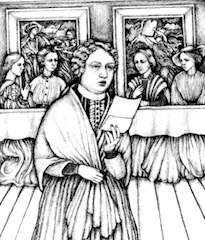|
J. William T. "Bill" Youngs, American Realities, Volume One:
Historical Episodes from First Settlements to the Civil War, Chapter Twelve |
"Elizabeth Cady Stanton, 1889," by Anna Elizabeth Klumpke
Courtesy of The National Portrait Gallery |
12. Reform in the Early Republic
|
SummaryIn antebellum America, reformers adopted many causes. Besides trying to eradicate slavery, they advocated temperance and favored improving schools, hospitals, and prisons. Women were involved in each of these movements and sometimes discussed their own disadvantaged status while meeting to help other groups. But it was not until 1848 that the first American women’s rights convention convened in Seneca Falls, New York. The meeting highlighted how law and custom placed women in an inferior position and exposed the inconsistency between the egalitarian ideals of the young republic and the injustice of sexual discrimination. The resolutions adopted at the meeting would influence the women’s rights movement for more than a century.
|
Author Reads From the Text
From her early childhood Elizabeth grappled with the problem of being a female in a society that favored boys and men. The dichotomy between the two worlds was reflected in the development of her personality. She was a lively, intelligent child with sparkling eyes, a pretty face, and a vibrant sense of humor, but beneath this animated exterior she was depressed, given to dark thoughts and frightening nightmares. Although well behaved, she believed that she was tainted with evil. This anxiety may have also developed from her Presbyterian upbringing, with its emphasis on humankind’s innate sinfulness, and from the rigorous standards of conduct imposed by her parents.
But her uneasiness must have fed also on her sense of discontent with her gender role. She was attracted to male activities. As a child, she was a tomboy—a phrase used then and today to describe a young girl who enjoyed sports. As she grew older, she longed for educational and vocational opportunities that were provided only for boys. What was the source of these outlandish longings? Surely they were not a woman’s ideas.
It did not initially occur to her that her ambitions might be natural human aspirations, and she feared that their source must be an evil force. As a child, Elizabeth had a recurrent dream in which she had been fathered by Satan, and he wanted to reclaim her. After such dreams she would awaken with horror and with a troubled mind would creep to the top of the staircase where she could listen to the adult voices from the room below. These human sounds calmed her, returning her to her daily world.
But her uneasiness must have fed also on her sense of discontent with her gender role. She was attracted to male activities. As a child, she was a tomboy—a phrase used then and today to describe a young girl who enjoyed sports. As she grew older, she longed for educational and vocational opportunities that were provided only for boys. What was the source of these outlandish longings? Surely they were not a woman’s ideas.
It did not initially occur to her that her ambitions might be natural human aspirations, and she feared that their source must be an evil force. As a child, Elizabeth had a recurrent dream in which she had been fathered by Satan, and he wanted to reclaim her. After such dreams she would awaken with horror and with a troubled mind would creep to the top of the staircase where she could listen to the adult voices from the room below. These human sounds calmed her, returning her to her daily world.

